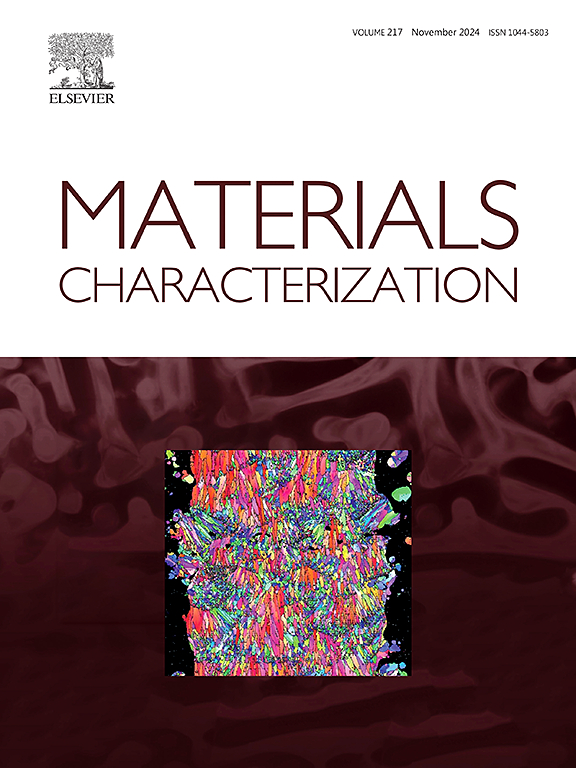用 Sn-1.0Ag-0.5Cu-Ti 合金金属化氮化铝低温焊点的剪切特性
IF 4.8
2区 材料科学
Q1 MATERIALS SCIENCE, CHARACTERIZATION & TESTING
引用次数: 0
摘要
研究了锡-1.0Ag-0.5Cu-xTi(SAC-xTi,其中 x = 2、4、6)粉末在 AlN 表面的润湿行为。在 900 °C 下加热 30 分钟后,SAC-xTi 粉末在 AlN 表面形成了高质量的锡基金属化层。在 250 ℃ 下,使用 SAC 焊膏成功地将预金属化的 AlN 焊接到了铜基板上。随着 SAC 中 Ti 含量的增加,润湿角逐渐增大,AlN 表面的 SAC-2Ti 粉末的最小润湿角为 8.2°。此外,在 AlN 表面还观察到均匀且连续的平坦预金属化层。然而,随着钛含量的增加,该层变得不连续,导致出现明显的表面不规则(凸起)。低温制备的铜/SAC/预金属化 AlN 接头具有以下典型的微观结构:Cu/Cu3Sn 层/Cu6Sn5 层/β-Sn 层(含 Ag3Sn 和 Cu6Sn5)/TiN 层/AlN。预金属化层对接头的剪切强度有显著影响,随着钛含量的增加,剪切强度降低。使用 SAC-2Ti 形成的带有预金属化层的接头的剪切强度峰值为 24.27 兆帕。随着钛含量的增加,断裂路径逐渐从焊料基体向 AlN 表面靠近。本文章由计算机程序翻译,如有差异,请以英文原文为准。
Shear properties of low-temperature soldered joints of aluminum nitride metallized with Sn-1.0Ag-0.5Cu-Ti alloys
The wetting behavior of Sn-1.0Ag-0.5Cu-xTi (SAC-xTi, where x = 2, 4, 6) powder on the AlN surface was investigated. The SAC-xTi powder developed a high-quality tin-based metallization layer on the AlN surface when heated at 900 °C for 30 min. The pre-metallized AlN was successfully soldered to the Cu substrate using SAC solder paste at 250 °C. The wetting angle gradually increased with rising Ti content in SAC, achieving a minimum wetting angle of 8.2° with SAC-2Ti powder on the AlN surface. Additionally, there was observed a homogeneous and sequential flat pre-metallized layer on the surface of AlN. However, the layer becomes discontinuous as the Ti content increases, leading to the appearance of significant surface irregularities (bumps). Low-temperature preparation of Cu/SAC/pre-metallized AlN joints with the typical microstructures of: Cu/Cu3Sn layer/Cu6Sn5 layer/β-Sn layer (containing Ag3Sn and Cu6Sn5)/TiN layer/AlN. The pre-metallized layer significantly influenced the shear strength of the joints, which decreased with increasing Ti content. The shear strength of joints with pre-metallized layers formed using SAC-2Ti peaked at 24.27 MPa. As Ti content increased, the fracture paths gradually approached the AlN surface from the solder matrix.
求助全文
通过发布文献求助,成功后即可免费获取论文全文。
去求助
来源期刊

Materials Characterization
工程技术-材料科学:表征与测试
CiteScore
7.60
自引率
8.50%
发文量
746
审稿时长
36 days
期刊介绍:
Materials Characterization features original articles and state-of-the-art reviews on theoretical and practical aspects of the structure and behaviour of materials.
The Journal focuses on all characterization techniques, including all forms of microscopy (light, electron, acoustic, etc.,) and analysis (especially microanalysis and surface analytical techniques). Developments in both this wide range of techniques and their application to the quantification of the microstructure of materials are essential facets of the Journal.
The Journal provides the Materials Scientist/Engineer with up-to-date information on many types of materials with an underlying theme of explaining the behavior of materials using novel approaches. Materials covered by the journal include:
Metals & Alloys
Ceramics
Nanomaterials
Biomedical materials
Optical materials
Composites
Natural Materials.
 求助内容:
求助内容: 应助结果提醒方式:
应助结果提醒方式:


